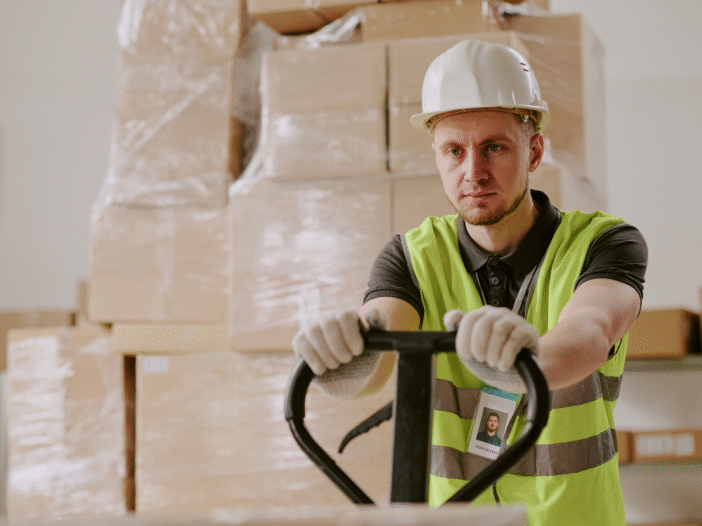
A risk assessment for construction work is a legal requirement, but most importantly, it is the foundation of accident prevention, cost control, and successful project delivery.
The construction industry faces some of the highest risks of any sector. In 2023–24, 51 construction workers lost their lives at work — accounting for one-third of all workplace fatalities in Great Britain, and a further 47,000 construction workers were injured.
In this article, we share evidence on how effective risk assessments reduce risks in construction and deliver measurable benefits for employees and businesses.
Why is a risk assessment for construction work essential?
Here are the main, evidence-supported reasons why risk assessments are essential in construction:
Protect lives
Construction is consistently one of the most dangerous industries in the UK, with workers far more likely to be killed or seriously injured than in most other sectors. While agriculture, forestry and fishing have a much higher fatality rate per 100,000 workers, construction still sees far more lives lost in total.
An effective construction site risk assessment is the foundation of accident prevention: it identifies hazards such as unstable scaffolding, fragile roofs, or unprotected edges, and ensures that practical safeguards (such as guardrails, harnesses, and safe systems of work) are put in place.
Failures in risk assessment are often highlighted in Health and Safety Executive (HSE) investigations. In one HSE investigation, a worker fell around four metres while climbing onto a box trailer using an unsecured ladder. He suffered multiple fractures to his hip and wrist. The investigation found there had been no risk assessment and concluded that the accident could have been prevented if the risks had been properly assessed and controlled.
Support compliance
Carrying out a risk assessment for building construction is a legal requirement under the Management of Health and Safety at Work Regulations 1999 (Regulation 3). This regulation requires every employer and self-employed person to make a “suitable and sufficient” assessment of the risks to employees and anyone else who may be affected by their work.
In the construction industry, this duty is reinforced by the Construction (Design and Management) Regulations 2015 (CDM 2015) which place additional responsibilities on clients, designers, and contractors to plan, manage, and monitor health and safety throughout a project.
A recent example illustrates the consequences of failing to carry out a risk assessment. Merchant Homes was fined £160,000 after a telehandler operator died when the vehicle reversed off an embankment. The HSE found that the company had not carried out a proper risk assessment of traffic routes on site and failed to manage the hazard of uneven ground, which led to the fatal event.
For more about the legal requirements of construction risk assessments, please read our article What are the legal requirements for a construction risk assessment?
Prevent financial losses
The financial impact of poor health and safety in construction is enormous. According to the HSE, around 2.5 million working days are lost each year in the sector due to injury and work-related illness. Of these, approximately 17% are linked to workplace injuries and 83% to ill health. That works out at about 1.3 lost working days per worker, which is slightly above the all-industry average of 1.1 days.
The overall cost is striking. In 2022/23, work-related ill health and injury in construction was estimated to cost the UK economy £1.4 billion, making up around 7% of the total £21.5 billion cost across all industries. These costs fall on employers, workers, and society through medical bills, compensation payments, lost productivity, and delays.
A structured risk assessment for construction work is central to reducing these losses. By identifying hazards early and applying proportionate construction risk control, employers can prevent costly accidents and unplanned stoppages.
Facilitate successful project delivery
A risk assessment for construction work is a cornerstone of effective project management.
A quantitative study of 321 large construction projects found that structured risk management practices, including systematic risk assessment, had a statistically significant positive effect on project outcomes. Projects where risk assessments were integrated into the planning phase were more likely to meet their time and budget targets compared to those where construction risk was managed weakly or reactively.
The study concluded that risk assessment provides “early warning signals” that enable project managers to make proactive adjustments, preventing cost overruns and schedule delays.
Improve resource allocation and efficiency
A peer-reviewed investigation into risk management in the construction industry highlighted the importance of early hazard identification for efficient use of resources.
By spotting risks (such as potential supply chain disruptions, design flaws, or hazardous working conditions) at the outset, organisations were able to allocate labour, equipment, and finances more effectively.
The study showed that projects with systematic risk assessment reported fewer stoppages and less waste, leading to improved economic performance and greater stakeholder satisfaction.
Build client and contractor confidence
A well-documented construction site risk assessment strengthens relationships with clients and contractors. Academic reviews of global construction practice emphasise that visible, structured approaches to construction risk control act as a signal of professionalism and competence.
Clients are more likely to award contracts to organisations that can demonstrate robust approaches to risk management in the construction industry, as this reduces the likelihood of disputes, reputational harm, and unexpected costs.
Practical tips for employers and contractors
For a risk assessment to be effective, the process needs to be lived and breathed on site. Here are some tips to follow:
Involve staff in the process
Workers who carry out the tasks often have the clearest view of the risks involved, making their input invaluable during a construction site risk assessment. Their day-to-day experience can highlight hazards that managers or safety officers might miss.
- Joint site walkarounds – bring operatives, subcontractors, and supervisors together to identify hazards in real time, each focusing on their area of expertise (e.g. scaffolders on edge protection, plant operators on vehicle movements).
- Risk assessment reviews – consult experienced workers when updating assessments to ensure controls are realistic and workable on site.
- Near miss reporting – encourage employees to report close calls and review them regularly to identify patterns before incidents occur.
- Feedback loops – act visibly on staff suggestions and report back (e.g. repairing faulty scaffolding the same day it is reported) to show their input makes a difference.
This involvement improves the accuracy of assessments and builds trust, ownership, and compliance.
Train employees to recognise hazards
Hazard recognition should be part of everyone’s role, not just supervisors or safety managers. A risk assessment is only effective if employees can spot and act on risks as they arise.
- Induction training – introduce new starters to the site’s core risks such as working at height, electricity, dust, and vehicle movement. Tailor inductions to the specific conditions of the site. Praxis42 offers IOSH-approved Health and Safety Induction Training that can be adapted to your organisation.
- Task-specific sessions – hold short, practical briefings before high-risk work begins, demonstrating key safeguards (e.g. how to inspect harnesses or check fragile roofs).
- Practical demonstrations – use hands-on learning such as spotting wear on lifting slings or testing emergency stop buttons.
- Real-world examples – use industry incidents and site near misses in training to highlight the consequences of overlooking hazards.
- Refresher training and toolbox talks – build short, rotating sessions into weekly briefings to keep awareness high as site conditions change.
- Empowerment to act – make it clear that everyone has the authority to stop unsafe practices and raise concerns.
Use technology for updates and monitoring
Construction sites change daily, so risk assessments must evolve in step with conditions. Digital tools can make this process fast and efficient.
- Real-time updates – supervisors can use mobile apps or cloud platforms to amend assessments instantly if conditions change, such as halting work at height in high winds.
- Instant communication – updates can be pushed directly to workers’ smartphones or tablets, ensuring no one is relying on outdated information.
- Dashboards and tracking – monitor outstanding actions, highlight incomplete checks, and show progress against safety objectives.
- Evidence capture – photos, videos, and digital signoffs create a clear audit trail of inspections and completed actions.
- Automated reminders – schedule alerts for recurring tasks like scaffold inspections or refresher training.
- Data-driven insights – analyse near miss and inspection data to identify recurring risks and improve construction risk control.
Technology ensures that assessments are “living documents” rather than paperwork filed away until audits.
Keep documents accessible
Even the best-written risk assessment is only useful if employees can find, read and understand it. Accessibility is key to making risk assessments a practical tool.
- Accessible formats – use plain language, translations where necessary, and diagrams or photos to ensure all workers can understand.
- Visible hard copies – post the latest assessments on noticeboards in cabins, site entrances, or near high-risk areas so they are always at hand.
- Digital access on demand – make versions available on tablets, smartphones, or intranet platforms so operatives can check them at the point of work.
- Clear communication of updates – when changes are made (e.g. altered traffic routes or scaffolding layouts), explain and distribute updated copies before work starts.
- Version control – label documents clearly with dates and version numbers, removing outdated copies immediately.
- Task-specific extracts – provide shortened versions for high-risk tasks so workers see exactly what applies to their job.
Accessible documents keep everyone aligned and prevent reliance on outdated or incomplete information.
Independent RAMS review for construction projects
A thorough risk assessment for construction work is essential for safeguarding people and ensuring projects run smoothly. To support this, Praxis42 offers an independent Risk Assessment and Method Statement (RAMS) review service tailored to the construction industry.
Our experienced consultants examine your RAMS to check they are practical, legally robust, and easy for your workforce to follow on site. An external review provides added assurance that your documentation is not only compliant but also effective at managing real-world construction risks.
Discover more about our RAMS review service and strengthen your approach to construction risk management. Speak to our team today on 0203 011 4242 or info@praxis42.com.

Adam Clarke
Managing Director (Consulting)
